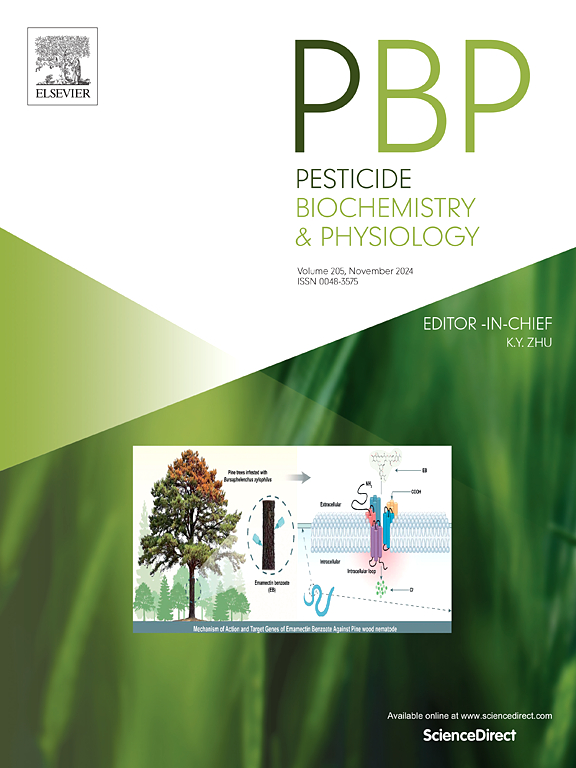Role of Bacillus atrophaeus B1 in gut on nicotine tolerance of the fall armyworm
IF 4.2
1区 农林科学
Q2 BIOCHEMISTRY & MOLECULAR BIOLOGY
引用次数: 0
Abstract
The fall armyworm (FAW), Spodoptera frugiperda is one of the most destructive polyphagous herbivores. Some detoxification genes have been proved to be involved in the adaptability to host plants in FAW, while the role of its gut microbiota on the responses of host switches, and their ability to adapt to new host plants remain poorly understood. Herein, we isolated five strains of nicotine-degrading bacteria from the gut of S. frugiperda larvae, among which Bacillus atrophaeus B1 exhibited the highest nicotine tolerance. This strain showed a minimum inhibitory concentration (MIC) value of 2 g/L and a nicotine degradation rate of 46.36 %. We sequenced the complete genome of B. atrophaeus B1 and 15 candidate genes were identified maybe related to nicotine degradation, among which GE003027, GE002849, GE002602, GE000220 and GE002708 had significantly higher expression when exposed to nicotine. Non-targeted metabolomics revealed 98 differentially accumulated metabolites (DAMs) under nicotine stress, which were 72 metabolites upregulated and 26 metabolites downregulated, and the pathways most affected involved xenobiotic biodegradation and metabolism, energy metabolism, and amino acid metabolism. B. atrophaeus B1 may accumulate 2-ketoglutaric acid and γ-aminobutyric acid during degradation of nicotine, which is non-toxic to S. frugiperda, and participated in the tricarboxylic acid (TCA) cycle. Additionally, 2-ketoglutaric acid and γ-aminobutyric acid were detected both in B. atrophaeus B1 and S. frugiperda treated with nicotine. Antibiotic treatment deprived most of the gut bacteria, followed by a decrease in tolerance of S. frugiperda to nicotine, and the nicotine degradation rate was significantly increased as expected after reinfection with B. atrophaeus B1. These findings provide new insights into the bacterial metabolism of nicotine degradation and offer a theoretical basis for understanding the rapid adaptability of S. frugiperda to various host plants.

求助全文
约1分钟内获得全文
求助全文
来源期刊
CiteScore
7.00
自引率
8.50%
发文量
238
审稿时长
4.2 months
期刊介绍:
Pesticide Biochemistry and Physiology publishes original scientific articles pertaining to the mode of action of plant protection agents such as insecticides, fungicides, herbicides, and similar compounds, including nonlethal pest control agents, biosynthesis of pheromones, hormones, and plant resistance agents. Manuscripts may include a biochemical, physiological, or molecular study for an understanding of comparative toxicology or selective toxicity of both target and nontarget organisms. Particular interest will be given to studies on the molecular biology of pest control, toxicology, and pesticide resistance.
Research Areas Emphasized Include the Biochemistry and Physiology of:
• Comparative toxicity
• Mode of action
• Pathophysiology
• Plant growth regulators
• Resistance
• Other effects of pesticides on both parasites and hosts.

 求助内容:
求助内容: 应助结果提醒方式:
应助结果提醒方式:


